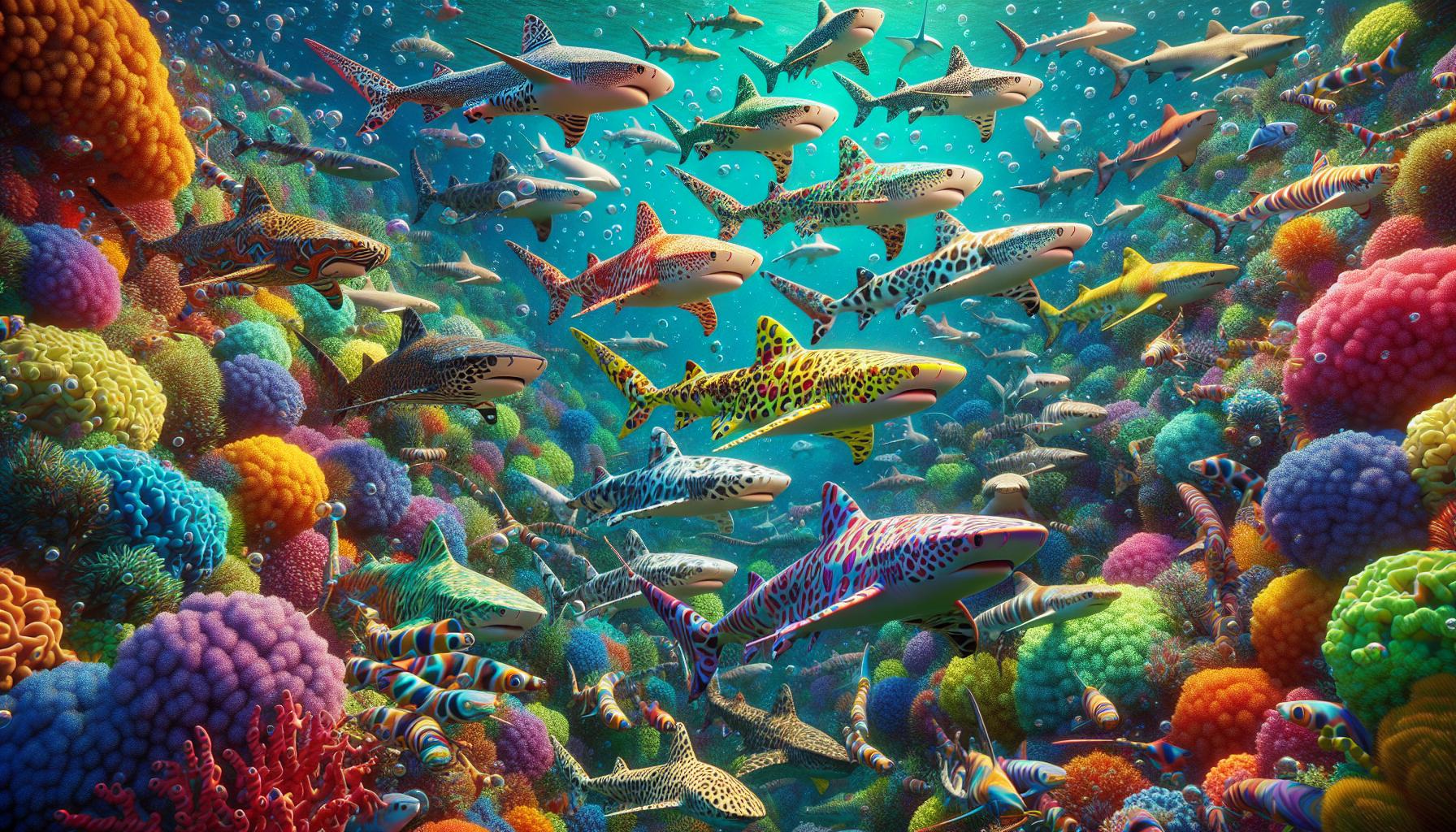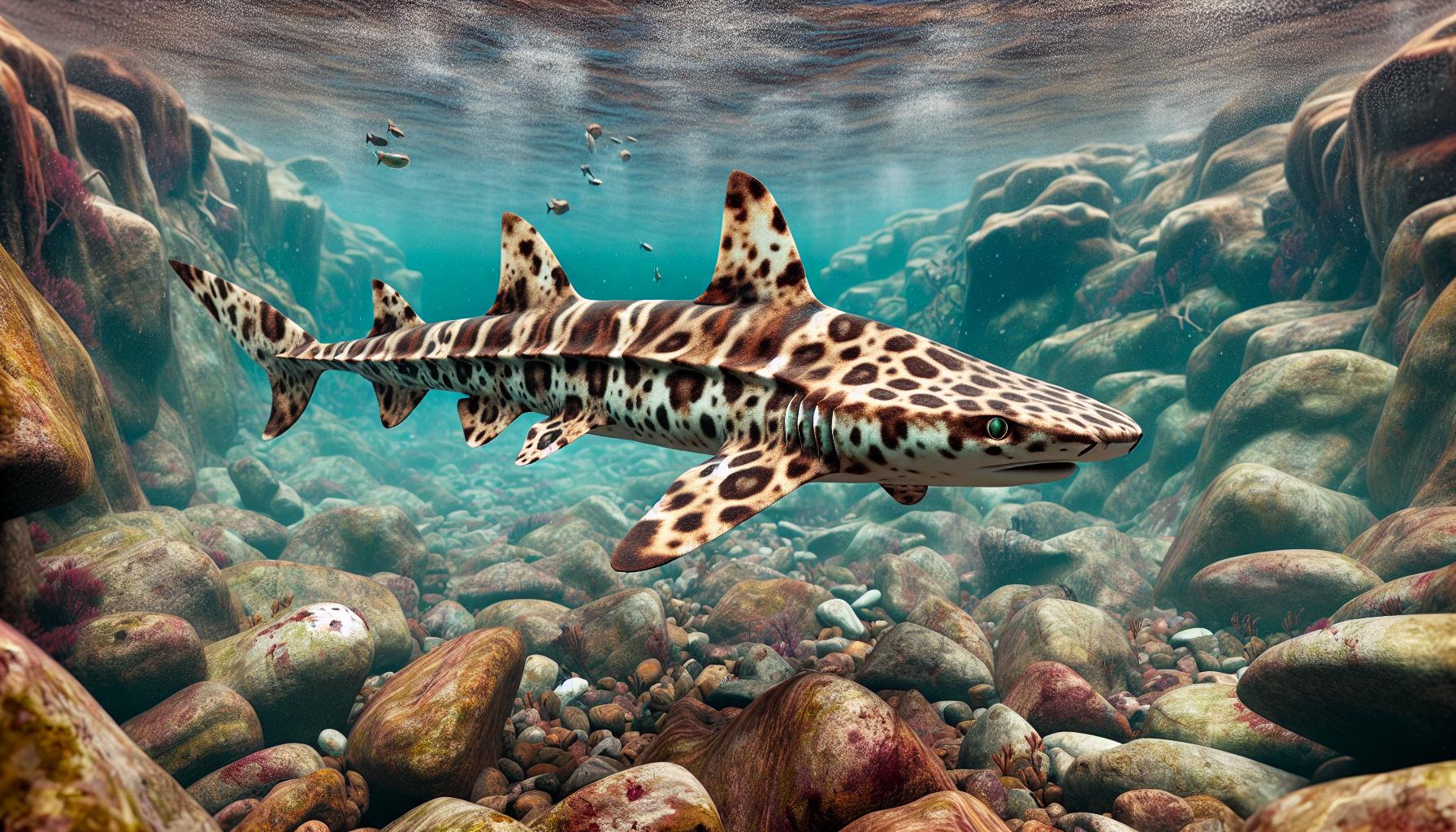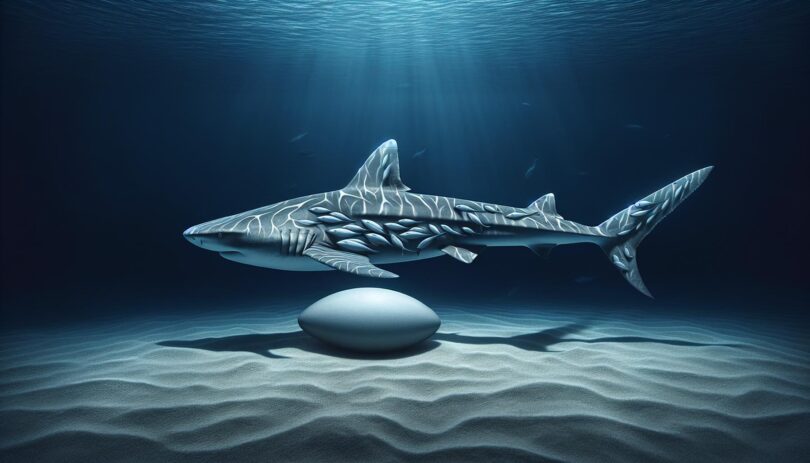Cat sharks, often overshadowed by their larger counterparts, are a fascinating group of small to medium-sized sharks that deserve a spotlight of their own. With their slender bodies and cat-like eyes, it’s easy to see how they’ve earned their name. They’re not just a single species but belong to a family known as Scyliorhinidae, which includes over 150 species.
I’ve always been intrigued by the diversity of marine life, and cat sharks, in particular, have caught my attention. They inhabit a variety of marine environments, from shallow coral reefs to the deep sea, each species with its unique adaptations and behaviors. Let’s dive into the world of cat sharks and discover what makes these creatures so captivating.
Key Takeaways
- Cat sharks belong to the Scyliorhinidae family, comprising over 150 diverse species that inhabit various marine environments, from shallow reefs to the deep sea, showing remarkable adaptability and resilience.
- Despite being smaller in size compared to other sharks, cat sharks play a crucial role in marine ecosystems, engaging in unique behaviors and reproductive strategies, such as laying “mermaid’s purses” (egg cases), which contribute to their diversity and survival.
- Their distinct physical features, including slender bodies and cat-like eyes equipped with a reflective layer called the tapetum lucidum, enhance their vision in dim lighting and allow effective navigation and hunting in their specific habitats.
- Cat sharks exhibit a wide range of colors and patterns that serve as camouflage against predators and as a mechanism for stealthy predation, showcasing the complexity and beauty of marine life through their evolutionary adaptations.
- The intricate balance of marine ecosystems is significantly influenced by cat sharks, as they control prey populations and serve as indicators of ocean health, underscoring the importance of ongoing research and conservation efforts to protect these captivating creatures.
Cat Sharks: A Fascinating Group of Small to Medium-Sized Sharks

In delving deeper into the enchanting world of cat sharks, I’ve uncovered that these are not your typical sharks. With over 150 species, the diversity within the Scyliorhinidae family is staggering. Each species brings its own unique twist to the shark formula, thriving in a variety of marine environments. From the shallow shores to the deep abyss, cat sharks have adapted to an impressive range of habitats.
What sets them apart is their size. Most cat sharks are small to medium-sized, making them less imposing than their larger counterparts. This size range, however, doesn’t make them any less fascinating. It actually contributes to their adaptability and the specific niches they occupy within the ecosystem. Their smaller size allows them to pursue prey and inhabit areas that larger sharks can’t, highlighting the importance of their role in maintaining the balance of marine life.
The allure of cat sharks also lies in their behavior and reproductive strategies. Many species lay eggs, which are often referred to as “mermaid’s purses,” a term that captures the imagination and showcases the whimsical side of marine biology. Observing these sharks in their natural habitat, noting how they interact with their environment and with each other, provides invaluable insights into the dynamics of marine ecosystems.
Their distinctive patterns and colors serve not only as camouflage but also as a subject of fascination for scientists and enthusiasts alike. The intricate designs seen on the hides of many cat shark species illustrate the beauty and complexity of aquatic life, making them a vivid testament to the biodiversity of our oceans.
Engaging with the world of cat sharks has deepened my appreciation for the subtleties and intricacies of marine ecosystems. Their small to medium size belies their significant impact on aquatic environments, proving that even the most unassuming creatures have roles that are indispensable to the health of our planet’s vast oceans.
The Slender Bodies and Cat-Like Eyes of Cat Sharks

When I first delved into the world of cat sharks, their slender bodies and captivating cat-like eyes immediately drew my attention. Cat sharks, with their slim profiles, are perfectly adapted to navigate through tight spaces and rocky crevices. This allows them to hunt smaller prey effectively, a trait not commonly seen in their larger shark cousins.
Their eyes, reminiscent of a domestic cat’s, are not just for show. These remarkable features give cat sharks enhanced vision in the dim lighting of the ocean’s depths. The reflective layer behind their retina, known as the tapetum lucidum, amplifies light, enabling them to see in conditions where other predators might struggle. This adaptation is crucial for their survival, providing them with a significant advantage in the low-light environments they often inhabit.
What’s fascinating about cat sharks is not just their physical adaptations but also their coloration and patterns. Ranging from subtle browns to vivid stripes and spots, these patterns are not merely aesthetic. They serve as excellent camouflage against the seafloor, allowing cat sharks to blend seamlessly into their surroundings. This not only aids in their stealthy approach to prey but also protects them from being easily spotted by larger predators.
Their size, typically smaller compared to other shark species, further enhances their survival strategies. By being smaller, cat sharks can exploit a variety of marine environments, from shallow coastal waters to the deeper, darker regions of the ocean. This versatility in habitat selection underscores the adaptability and resilience of cat sharks, elements that have ensured their survival through ages.
As I continue to explore the intriguing aspects of cat sharks, I’m consistently amazed by both their physical and behavioral adaptations. Their role in marine ecosystems is more critical than it might appear at a glance, making them a fascinating subject for further study and conservation efforts.
Exploring the Scyliorhinidae Family: Over 150 Species
When delving into the biodiversity of the Scyliorhinidae family, commonly known as cat sharks, I’m struck by the sheer diversity within this group. With over 150 species, these sharks display an incredible range of sizes, colors, and habitats that fascinate researchers and shark enthusiasts alike. From the well-known chain catshark to the obscure dusky cat shark, each species contributes uniquely to the marine ecosystem.
One fascinating aspect is the size variation among these species. For example, the dwarf lanternshark, one of the smallest members of the Scyliorhinidae family, measures just under 8 inches in length, while larger species like the nursehound can grow up to 5 feet. This size disparity not only showcases the evolutionary adaptability of cat sharks but also their ability to occupy a variety of ecological niches.
| Species | Common Name | Length |
|---|---|---|
| Etmopterus perryi | Dwarf Lanternshark | < 8 inches |
| Scyliorhinus stellaris | Nursehound | up to 5 feet |
Their reproductive methods are equally diverse, adding another layer of complexity to their study. Some species of cat sharks are oviparous, laying eggs that hatch outside the mother’s body, while others are ovoviviparous, hatching eggs internally to give birth to live young. This reproductive diversity highlights the adaptability of cat sharks, enabling them to thrive in various marine conditions.
Moreover, the role of cat sharks in marine ecosystems cannot be overstated. Their diet, predominantly consisting of small fishes and invertebrates, positions them as vital for maintaining the balance within their habitats. As both predator and prey, cat sharks exemplify the interconnected nature of marine life, underscoring the importance of their conservation.
Acknowledging the vast diversity and ecological significance of the Scyliorhinidae family further emphasizes the need for ongoing research and conservation efforts. Their resilience and adaptability make cat sharks a fascinating subject of study, revealing the complexity and beauty of marine ecosystems.
Inhabiting Diverse Marine Environments: From Shallow Coral Reefs to the Deep Sea
Cat sharks have carved out niches in a remarkably wide range of marine environments. My fascination with these creatures grows as I delve into the diverse habitats they occupy, from the bustling life of shallow coral reefs to the mysterious depths of the open sea. Understanding where these sharks live not only highlights their adaptability but also underscores the ecological richness of our oceans.
In the shallow waters, many cat shark species find refuge among coral reefs and seagrass beds. Here, the Chain Catshark thrives, enveloped in a world teeming with prey and places to hide. Coral reefs offer an unparalleled biodiversity that cat sharks exploit for food and protection. The vibrant colors and patterns of certain cat shark species blend seamlessly with the reef, making them formidable ambush predators.
As we journey farther from shore, the ocean depth increases and light diminishes, ushering us into the realm of the deep sea. It’s here that cat sharks reveal their true versatility. Species like the Gulper Shark inhabit depths exceeding 2,000 meters, where sunlight is a stranger. These environments are starkly different from the coral reefs; they are vast, cold, and under immense pressure. Yet, cat sharks have adapted beautifully, many developing unique physiological traits to survive. Some species produce light through bioluminescence, a dazzling survival strategy that can attract prey or provide camouflage against the sparse light trickling down from above.
Adaptations That Ensure Survival
Adapting to such varied environments requires a suite of evolutionary strategies. Cat sharks have developed:
- Specialized senses that enable them to hunt in the dark abyss
- Unique reproductive traits to ensure offspring survival in challenging conditions
- Abilities to regulate their buoyancy to float effortlessly between depths
These adaptations are not just remarkable feats of evolution; they’re a testament to the resilience of cat sharks. By thriving in environments ranging from the shallow to the abyssal, cat sharks play vital roles in marine ecosystems across the globe. Their presence helps regulate prey populations and provides insight into the health of our oceans.
Unique Adaptations and Behaviors of Cat Sharks
Cat sharks, with their diverse range and fascinating behaviors, are a testament to the wonders of evolution. Their unique adaptations not only ensure their survival but also play a critical role in maintaining the balance of marine ecosystems. Let’s delve into some of these remarkable traits and habits that set cat sharks apart.
Firstly, these elusive predators have developed extraordinary sensory capabilities. For instance, cat sharks boast highly sensitive lateral lines that detect vibrations in the water, allowing them to zero in on hidden or camouflaged prey with remarkable accuracy. This sensory adaptation is crucial in the murkier depths of their habitat, where visibility is often low.
Another noteworthy trait is their reproductive strategy. Many cat sharks exhibit oviparity, laying tough, leathery egg cases known as “mermaid’s purses.” These egg cases are often attached to corals or seaweeds and can take several months to hatch, providing a protective casing against predators. This method of reproduction ensures that their offspring have a fighting chance from the moment they enter the world.
Cat sharks also exhibit fascinating camouflage and defensive mechanisms. Their skin patterns and colorations can mimic the textures and colors of their surroundings, rendering them nearly invisible to both predators and prey. Furthermore, some species have developed the ability to curl their bodies into a U-shape and cover their heads with their tails, a behavior that likely serves to deter potential threats.
Lastly, the diet of cat sharks is as varied as their habitats. Ranging from small fish and cephalopods to crustaceans, their opportunistic feeding habits underscore their adaptability. Yet, despite their predatory nature, cat sharks maintain a delicate balance within their ecosystems, emphasizing their role as both predators and prey.
Understanding these unique adaptations and behaviors is key to appreciating the complexity of cat sharks and their significance in marine life. Their continued study sheds light on the intricacies of ocean ecosystems and the importance of preserving these diverse habitats.
Conclusion
Diving into the world of cat sharks has been a remarkable journey. Their unique adaptations, from exceptional sensory capabilities to intricate defensive mechanisms, underscore the complexity of marine life. It’s clear that cat sharks play a pivotal role in their ecosystems, acting as both predators and prey. Their contribution to the balance of marine environments can’t be overstated. As we continue to explore and understand the depths of our oceans, it’s vital to recognize the importance of preserving these habitats for creatures like cat sharks. Their survival and the health of our oceans are intricately linked. By protecting their world, we safeguard our own.
Frequently Asked Questions
What are cat sharks known for in their natural habitats?
Cat sharks are known for their unique adaptations and behaviors that allow them to thrive in marine ecosystems. They possess highly sensitive lateral lines for detecting prey, effective camouflage, and defensive mechanisms to blend with their surroundings and protect themselves.
How do cat sharks reproduce?
Cat sharks reproduce through oviparity, meaning they lay eggs. The eggs are encased in tough cases that offer protection to the offspring, ensuring their survival in the wild until they hatch.
What do cat sharks eat?
Cat sharks have a varied diet that primarily consists of small fish and crustaceans. Their feeding habits contribute to the complexity of the marine food web, serving as both predators and prey within their ecosystems.
Why is it important to understand cat shark behavior and adaptations?
Understanding cat shark behavior and adaptations is crucial for appreciating the complexity of marine ecosystems. These insights help underline the importance of preserving marine habitats, as cat sharks play a key role in maintaining the ecological balance of the oceans.

